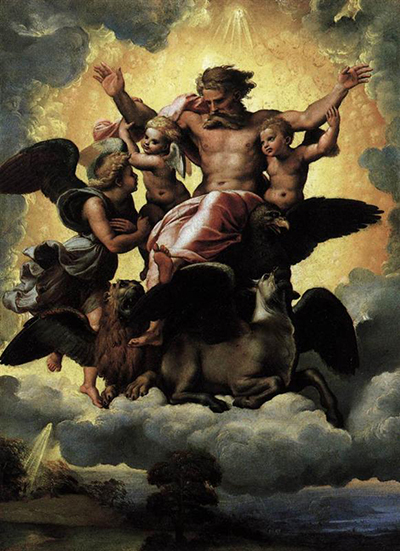The Vision of Ezekiel was completed around the year 1518 during the High Renaissance. This painting by Raphael measures 40 x 30 cm and is believed to be a painting created to pay homage to a fellow Italian artist, Michelangelo.
This artwork is remembered by a Renaissance art biographer named Giorgio Vasari as Vincenzo Ercolani's property. There is a trace of payment this Bolognese nobleman made to Raphael for eight gold coins in 1510. However, this is just considered a down payment because the work cannot be dated back before 1518. As early as 1589, this art was ceded significant I de' Medici in France and placed at the Uffizi. The painting is believed to be at the Palazzo Pitti in 1697. Though the work was, in one circumstance, considered to be designed by Giulio Romano, while Raphael was only providing the drawing, it has been eventually assigned to Raphael.
In a vision, prophet Ezekiel sees a man appearing sitting on a throne which is shaped by four creatures. These creatures have different faces: the face of an ox, an eagle, a lion, and a man. This "appearance" speaks to prophet Ezekiel, who realises God himself is speaking to him. In the painting, Ezekiel is shown as the small figure in the rays of light at the bottom left of the painting. St Hieronymus, a church father who lived between the 347 and 420 AD, used these four creatures to symbolise the four evangelists. The man symbolised Matthew, the lion - Mark, the ox - Luke and the eagle - John.
This piece of art was made from oil painting on panel. Oil painting involved painting on the board using pigments with a mechanism of drying the oil as the binder. Some of the conventional oils that are believed to have been used are poppy seed oil, linseed oil, safflower oil, and walnut oil. The choice of oil used has a great impact on the properties of oil paint. Such features include drying time and the level of yellowing. Some differences, which depend on the oil, can be seen even on the sheen of this painting. The oil can be boiled with some resin, such as frankincense or pine resin, to bring out a varnish prized for the body and gloss of the painting.
The artist used varying oils in this painting to bring out specific pigments and effects. The paints themselves also developed particular consistencies depending on the medium that Raphael used. He was heavily influenced by the works of Michelangelo, Fra Bartolommeo, Leonardo da Vinci and Pietro Perugino who also trained him before moving to Florence. His work is much admired for its ease of composition, clarity of form, and visual achievement of Neoplatonic ideals of the human grandeur. Most modern artists today reproduce his works through various techniques. French troops had robbed this panel in 1799. They took it to Paris, from Florence but after Napoleon's defeat, the panel was brought back to Florence in 1816. The painting now still is at the Galleria Palatina of Palazzo Pitti.




